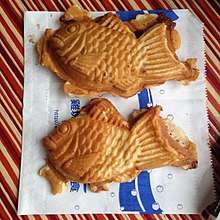Bungeo-ppang
 Bungeo-ppang being sold in Toronto | |
| Place of origin | Korea |
|---|---|
| Main ingredients | Wheat flour, red bean paste |
| Similar dishes | Taiyaki, gukhwa-ppang |
| Korean name | |
| Hangul | 붕어빵 |
|---|---|
| Revised Romanization | bungeo-ppang |
| McCune–Reischauer | pungŏ-ppang |
| IPA | [puŋ.ʌ.p͈aŋ] |
Bungeo-ppang (붕어빵; "carp bread") is a fish-shaped pastry stuffed with sweetened red bean paste.[1] It is one of the most common winter street food in Korea.[2][3] It is often sold at street stalls, grilled in an appliance similar to a waffle iron, but with fish-shaped molds. Although red bean paste is the standard filling, many bungeo-ppang that are sold as street food are filled with pastry cream (called "choux-cream" in Korea), pizza toppings, chocolate, and so on.
Etymology
The word bungeo-ppang is a compound of "carp (bungeo)" and "bread (ppang)" the pastry, however, does not contain any ingredients from its namesake fish or any other fish, rather the name comes from the shape of the pastry.
History
Bungeo-ppang was derived from a similar Japanese dish, taiyaki (baked sea bream), introduced to Korea around 1930s during the Japanese forced occupation period.[4] According to a 2011 book, Bungeoppang Has a Family Tree, bungeo-ppang began as the mix of Western waffles and Eastern dumplings, as the taiyaki itself was a Japanese adaptation of Western waffles introduced in Japan in the 18th century.[4][5] The change of fish-shaped pastry continued, as the sea bream-shaped taiyaki became carp-shaped bungeo-ppang in Korea.[1] Although bungeo-ppang's popularity did not last long, it found its way back into popularity during the 1990s with the retro craze in South Korea.[6]
Recently, more people are looking for Bungeo-ppang. So, to provide information on remaining stalls, enthusiasts nationwide made a “bungeoppang map.” Through Google Maps, users mark stalls’ locations with brief reviews, prices and opening hours, and share the details with others. [7]
Preparations
Bungeo-ppang batter is made up of wheat flour, baking powder, water and/or milk, and optionally eggs. The batter is poured into a fish-shaped mold in the bungeo-ppang grill, an appliance similar to a waffle iron. Sweetened red bean paste with bits of broken beans and bean husk is added, and then more batter is poured to encase the red bean paste. The mold is then closed, and the pastry is grilled until golden and crispy.[8]
Gallery
.jpg) Red bean paste in bungeo-ppang
Red bean paste in bungeo-ppang Binggrae's Melona Waffle, an ice cream based on bungeo-ppang
Binggrae's Melona Waffle, an ice cream based on bungeo-ppang Bungeo-ppang served in Gardena, California
Bungeo-ppang served in Gardena, California
See also
References
- 1 2 "bungeo-ppang" 붕어빵. Standard Korean Language Dictionary (in Korean). National Institute of Korean Language. Retrieved 14 March 2017.
- ↑ Carruth, David (28 November 2016). "10 Korean Winter Street Foods To Bear The Cold For". 10 Magazine. Retrieved 14 March 2017.
- ↑ Vis, Karin-Marijke (14 June 2016). "6 Traditional Vegetarian Snacks in South Korea". Paste. Retrieved 14 March 2017.
- 1 2 Lee, Woo-young (23 April 2014). "[Uniquely Korean] Street food evolves". The Korea Herald. Retrieved 28 April 2017.
- ↑ Yoon, Deok-no (2011). Bungeoppangedo jokboga itda 붕어빵에도 족보가 있다 [Bungeoppang Has a Family Tree] (in Korean). Jeonju, Korea: Cheongbori. pp. 18–25. ISBN 978-89-965021-2-8.
- ↑ 박, 정도 (25 November 2012). "추운 겨울 붕어빵으로 온정 느껴 보세요". The Kookje Daily News (in Korean). Retrieved 28 April 2017.
- ↑ Herald, The Korea (2018-02-28). "[Video] No fish in fish-shaped bread? 'Cause it's bungeoppang". Retrieved 2018-04-24.
- ↑ Goldberg, Lina (22 February 2013). "Asia's 10 greatest street food cities". CNN. Retrieved 11 April 2012.